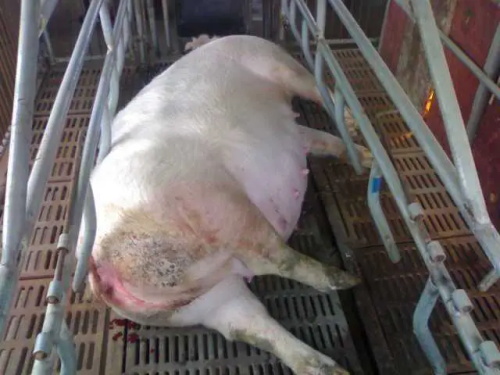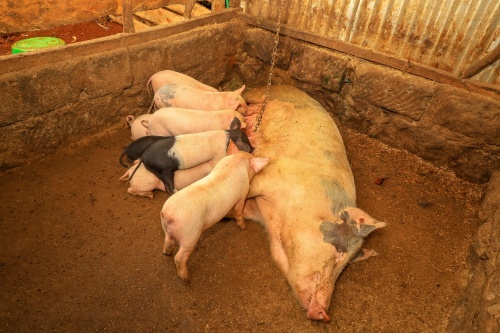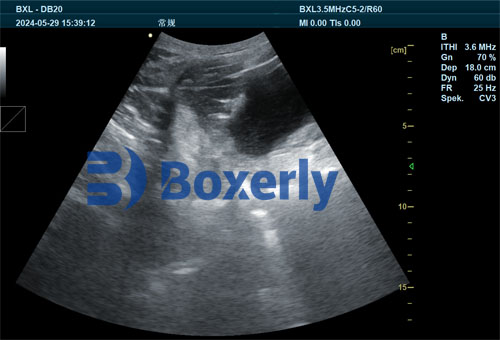In modern pig farming, precision in reproductive management is crucial for productivity, animal welfare, and profitability. A typical sow’s gestation period ranges from 112 to 115 days. But what happens when a sow remains pregnant for over 120 days with no signs of farrowing? While rare, this situation raises urgent questions about diagnosis, intervention, and potential causes. In this article, I will explore the possible reasons behind prolonged gestation in sows, how farmers in various countries address this issue, and the role of ultrasonography (commonly referred to as ultrasound) in making informed decisions.

Understanding Normal Sow Gestation
On average, a sow’s pregnancy lasts about 114 days—commonly remembered by the formula "3 months, 3 weeks, 3 days." However, various factors such as genetics, breed, litter size, hormonal balance, and even environmental conditions can slightly influence the duration.
In healthy conditions, signs of approaching labor—such as udder development, restlessness, and reduced feed intake—appear in the final few days. When these signs are absent past day 115, and certainly by day 120, farmers should begin to suspect abnormality.
Potential Causes of Prolonged Gestation
1. Fetal Mummification or Death
If one or more fetuses die in utero, the sow’s body might delay labor, especially if no live fetuses remain to trigger parturition. Ultrasonography is essential in such cases for determining fetal viability and number.
2. Hormonal Imbalance
Parturition in pigs is triggered by a complex interaction between fetal and maternal hormones, particularly estrogen, prostaglandins, and oxytocin. If this hormonal cascade fails to occur due to endocrine disorders, labor may not begin spontaneously.
3. Breed-Related Variations
Certain breeds—especially older heritage lines—may naturally gestate longer. Studies from European farms have shown that Landrace and Yorkshire sows tend to deliver closer to 113 days, while some Duroc lines may go up to 117 days.
4. Incorrect Breeding Records
Sometimes the issue isn’t physiological but clerical. Inaccurate heat detection or mistaken breeding dates can cause farmers to believe a pregnancy is overdue when, in reality, it is within normal range. A veterinary ultrasound performed between 25–35 days post-breeding can help establish more accurate due dates.
5. Small Litter Size
Sows with fewer piglets—especially gilts with 1–3 fetuses—tend to gestate longer. This is attributed to lower hormonal signaling from the fetuses to initiate labor.
6. Toxins or Disease
Infections such as Porcine Reproductive and Respiratory Syndrome (PRRS), parvovirus, or leptospirosis can result in reproductive failure, mummified fetuses, or disrupted labor mechanisms. Certain feed contaminants like zearalenone (a mycotoxin) can also interfere with hormone regulation.

Veterinary Assessment: The Role of Ultrasonography
In countries such as the United States, Canada, and Denmark, veterinarians rely heavily on real-time B-mode ultrasound to examine sows that are overdue. Using a veterinary-grade ultrasound machine, such as those in the BXL series, professionals can assess:
Fetal Heartbeats: Presence and frequency of fetal cardiac activity confirm viability.
Fetal Movement: An active fetus generally indicates a healthy pregnancy.
Uterine Fluid: The presence of cloudy or excessive fluid may suggest infection or fetal death.
Number and Position of Fetuses: Useful for determining whether a single retained piglet is blocking parturition.
Ultrasound is non-invasive, safe, and provides immediate feedback—making it ideal for urgent diagnostics in late gestation.
Decision-Making After 120 Days
When a sow has surpassed 120 days of gestation with no signs of farrowing, and an ultrasound confirms either fetal distress or no fetal movement, several clinical options exist:
1. Induction of Labor
Administering prostaglandin F2α (PGF2α) is a standard method to induce farrowing. In many developed farming systems, this is only done after confirming normal fetal condition and uterine readiness. Oxytocin may be added later to enhance contractions.
2. Caesarean Section (C-Section)
Though rare, C-sections may be performed in high-value sows or where valuable piglets are at risk. This practice is more common in North America and parts of Europe where individual animal value is high.
3. Euthanasia (in extreme cases)
If the sow is in distress, carrying dead fetuses, or suffering uterine rupture, humane euthanasia may be necessary. This decision is taken only after all other interventions fail.
4. Watchful Waiting
If the sow is in good health, shows no signs of distress, and ultrasound indicates live fetuses, many veterinarians recommend waiting up to 122–123 days before intervening, especially if breeding date errors are suspected.

Practical Experiences from Abroad
United States: On large swine operations, accurate data tracking is key. Most farms use digital management systems that sync breeding records with ultrasound results. Once a sow reaches 115 days without signs of farrowing, she is moved to a monitored pen, and veterinary scans are initiated.
Netherlands: Farmers often rely on minimal intervention and prioritize natural farrowing, but if a sow reaches day 120, hormonal induction becomes standard practice—only after confirming fetal viability via ultrasonography.
Australia: Due to the high cost of veterinary services in remote areas, producers often train farm staff to use portable ultrasound scanners to assess gestation stages. Machines with long battery life and waterproof design, like the BXL-V50, are favored for their durability and image clarity in harsh environments.
Preventive Measures to Avoid Extended Gestation
1. Accurate Breeding Records
Maintaining precise breeding logs, including observed heat signs and actual insemination dates, is fundamental. Synchronization protocols can help align estrus and minimize confusion.
2. Routine Ultrasound Checks
A routine scan at 28–35 days can verify pregnancy and help establish an accurate due date. A follow-up scan around day 100 can assess fetal condition and anticipate complications.
3. Nutrition and Body Condition Monitoring
Over-conditioned sows (with excess backfat) are at risk for farrowing complications. Balanced diets and routine body condition scoring (BCS) help reduce risk.
4. Disease Prevention
Vaccination schedules for PRRS, parvovirus, and leptospirosis should be rigorously followed. In countries with advanced swine production systems like Germany and Canada, biosecurity protocols are mandatory to prevent reproductive losses.
When in Doubt, Use Ultrasound
Whether you're managing a small family farm or a large-scale commercial swine operation, the ability to non-invasively monitor pregnancy progression is invaluable. With a reliable ultrasound machine, farmers and vets can:
Confirm gestational age
Detect abnormalities
Make time-sensitive decisions
Avoid unnecessary interventions
The introduction of user-friendly, portable veterinary ultrasound devices such as the BXL-V50 has empowered more producers worldwide to diagnose and respond to reproductive issues on-site—cutting down costs and improving animal outcomes.

Conclusion
A sow pregnant beyond 120 days without signs of farrowing is a signal that something might be wrong. While it can stem from natural variation or record-keeping errors, it may also indicate serious health issues. Internationally, veterinarians agree that ultrasonography is the most effective tool for evaluating late-term pregnancy.
By combining accurate records, appropriate ultrasound use, and informed decision-making, farmers can protect both animal welfare and farm profitability. Technology like the BXL-V50 is bringing diagnostic power into the hands of producers themselves, helping to bridge the gap between veterinary insight and everyday farm needs.
References
Main, R. G., & Holden, P. J. (2022). Practical Reproductive Management in Swine Herds. Journal of Swine Health and Production.
Veterinary Diagnostic Laboratory. (2023). "Ultrasound Use in Sow Reproductive Management." University of Minnesota. https://www.vdl.umn.edu/sow-ultrasound
European Pig Health Network. (2021). "Managing Prolonged Gestation in Breeding Sows." https://www.pighealth.org/prolonged-gestation
Iowa State University Extension. (2023). "Sow Parturition and Farrowing Challenges." https://www.extension.iastate.edu/sow-farrowing
Australian Pork Limited. (2023). "Ultrasound in Pig Production." https://australianpork.com.au/ultrasound-pigs
tags:
Text link:https://www.bxlultrasound.com/ns/846.html


